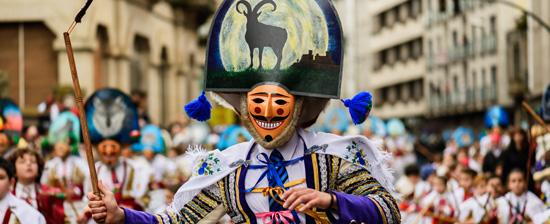We’ve covered quite a lot of bizarre festivals over the years. However, we’ve never focused specifically on the oddly violent ones. Detailed here are the top 10 unique and puzzling celebrations with pain at their core.
Entroido Carnival: Spain

Entroido Carnival takes place in Laza, Spain, and lasts for three days. On the first day, men dress up in terrifying wooden masks and march through the street with whips. They represent the Galician taxmen who policed the townspeople in the 16th century. Get in their way or exist near them and you’re gonna get a whipping. Monday is the most violent day of the festival. It’s centered on a practice called farrapada (“ragging”). Muddy rags are thrown indiscriminately at anything with a pulse.
Cotswold Olimpick Shin-Kicking: England

http://www.lovingthecotswolds.com
The annual Cotswold Olimpick Games are home to a variety of events. Many are just as archaic as the spelling of “Olympic.” However, the festival’s most popular and violent event is the shin-kicking championship. Competitors place their hands on each other’s shoulders. In that position, they must wrestle for leverage to unleash a flurry of kicks to their opponent’s shins. The bout ends when one competitor can take no more. At this point, “sufficient” is all they need state. Iron-capped boots aren’t allowed, and competitors’ trouser legs are stuffed with straw for cushioning. Also, they wear shepherds’ smocks, which are essentially the same as lab coats.
Agni Keli: India

In Mangalore, India, devout Hindus gather to appease the goddess Durga by throwing burning palm leaves at each other. Participants meet at the local river for a communal and spiritually significant cleansing. Then it’s time to play some flaming dodgeball.
Participants divide into two groups. From there, palm-built torches are hurled at the opposing side. The more people are hit, the more Durga is impressed.
Rouketopolemos (The Rocket War): Greece

http://www.worldfestivaldirectory.com
Easter night in Vrontados, Greece, is not a peaceful time. Two rival churches (Saint Mark and Panagia Erithiani) have been competing with each other for centuries. Every year, both churches attempt to settle the score by launching fireworks in the other’s direction. The loser is the church whose bell gets hit first. The surrounding buildings have to be protected with metal sheets, or they will suffer significant damage. In 2016, the event was canceled due to safety concerns.
The Battle of the Oranges: Italy

The origin of the annual Battle of the Oranges in Ivrea, Italy, is unclear. The legend goes that around the 12th century, the city was ruled by a particularly nasty marquis. Mad on power, he attempted to rape a local miller’s daughter. She ended up decapitating him and inspired a revolt in which the palace was burned to the ground. The festival is a reenactment of this revolt. Only instead of stones and whatever other projectiles were used against the marquis’s men, now the battle is solely fought with oranges.
Bolas De Fuego: El Salvador


In 1658, the volcanic eruption of El Playon destroyed the town of Nixapa in El Salvador. Survivors relocated to what is modern-day Nejapa. The Bolas de Fuego event is held every August 31 in commemoration. In the three months leading up to the event, participants construct over 1,500 apple-sized balls of kerosene-soaked cotton. Amazed tourists hide behind their camera phones as the fireballs begin to sail through the night sky. Most participants’ faces are also daubed with intimidating face paint.
Saidai-ji Eyo Hadaka Matsuri (Festival of Naked Fighting Men): Japan

Hadaka Matsuri roughly translates to “Naked Festival.” Technically, no one’s really naked. The 9,000 exclusively male participants all wear loincloths—identical to those worn by sumo wrestlers. A priest throws around 100 sacred sticks into the crowd. It’s thought that luck will be bestowed on any man who manages to shove a stick into a rice-filled box called a masu.
Festa De Sao Joao Do Porto: Portugal

The festival’s official English name is the Festival of St. John of Porto. It takes place every year on June 23 and attracts thousands of people to the Portuguese city’s center. The tradition follows that the leeks would be whacked on the heads of loved ones to aid their sexual performance. In the 20th century, as they were presumably sick of the annual bruising, locals switched over to using plastic hammers instead of leeks.
Takanakuy: Peru

Takanakuy roughly means “when the blood is boiling.” It takes place in the Chumbivilcas Province of Peru on Christmas Day. During the ceremonial proceedings, five traditional characters are portrayed, including Negro. The tiny province of Chumbivilcas, with a population of around 300, sees its greatest influx of tourists during the event. Over 3,000 people flock to see the face-punching. It’s not uncommon to see women and children take part, but it’s mostly men. Fists are wrapped in cloths, and the contest ends when an opponent is knocked out or the referee intervenes.
The Abare Festival: Japan

Also known as the Fire and Violence Festival, the Abare Festival is held on the first Friday and Saturday of July. The bizarre rituals involved are largely fueled by sake, and it is encouraged to cause chaos as this will please Susanoo-no-Mikoto, the Shinto god of sea and storms.
Related Content
This post was created with our nice and easy submission form. Create your post!






Comments
Loading…